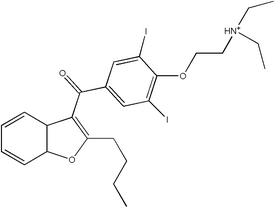Adding amiodarone to beta blocker therapy significantly reduces shocks in patients with an implantable cardioverter defibrillator (ICD), thereby improving tolerability, Stuart J. Connolly, MD, said.
Patients with an ICD routinely report anxiety, depression, fear of the device firing, and fear of death when the device fires, Dr. Connolly said. A recent study by Mayo Clinic investigators found that 24% of ICD patients have daily anxiety related to the device, and at 2 years postimplantation, 14% continue to report a daily preoccupation with their ICD.
In the Optimal Pharmacological Therapy in Implantable Cardioverter Defibrillator Patients (OPTIC) trial, 412 patients implanted with a dual-chamber ICD for life-threatening arrhythmias were randomized to receive a beta blocker alone, amiodarone plus a beta blocker, or sotalol. To be eligible, patients had to have documented sustained ventricular tachycardia (VT) or ventricular fibrillation (VF)/cardiac arrest with ejection fractions of 40% or less, or inducible VT or VF with ejection fractions of 40% or less or recent unexplained syncope.
The target doses of the beta blockers used were metoprolol, 100 mg/d; bisoprolol, 10 mg/d; and carvedilol, 50 mg/d. The target for patients assigned to amiodarone was 800 mg/d for the first 2 weeks, 400 mg/d for the following 4 weeks, and then 200 mg/d thereafter. Sotalol recipients received 240 mg/d in 2 or 3 divided doses (160 mg/d if creatinine clearance was 30 to 60 ml/min).
The risk of any ICD shock during the first year after implantation was lower among patients in the amiodarone and beta blocker group, compared with those taking beta blocker alone or sotalol. The annual risk of shock was 10.3% in patients assigned to amiodarone/beta blocker (p<0.001 vs. beta blocker alone) compared with 24.3% for sotalol (p=0.055 versus beta blocker alone) and 38.5% for beta blocker alone.
"The results represent a huge reduction in shocks and a big improvement in quality of life," said Dr. Connolly, professor, department of medicine, and director of the arrhythmia service and electrophysiology laboratory, McMaster University, Hamilton, Ontario, Canada.
Amiodarone/beta blocker treatment reduced appropriate, inappropriate, and frequent shocks. The annual rate of appropriate ICD shocks was 22.0%, 6.7%, and 15.1% in the beta blocker monotherapy, amiodarone/beta blocker, and sotalol groups, respectively; and the annual rate of inappropriate ICD shocks was 15.4%, 3.3%, and 9.4%, respectively. The mean number of shocks per patient during follow-up was 4.32 among beta blocker alone recipients, 0.51 in the amiodarone/beta blocker recipients, and 0.93 in the sotalol recipients.
COPYRIGHT 2005 Advanstar Communications, Inc.
COPYRIGHT 2005 Gale Group



